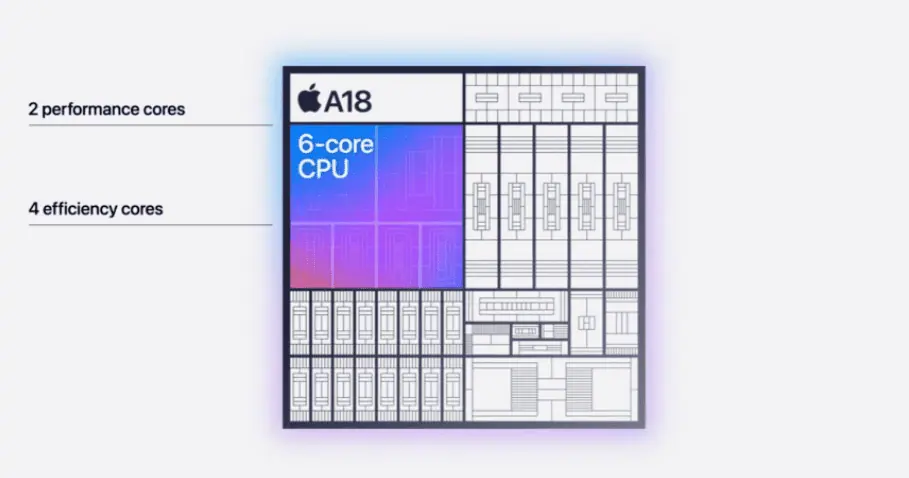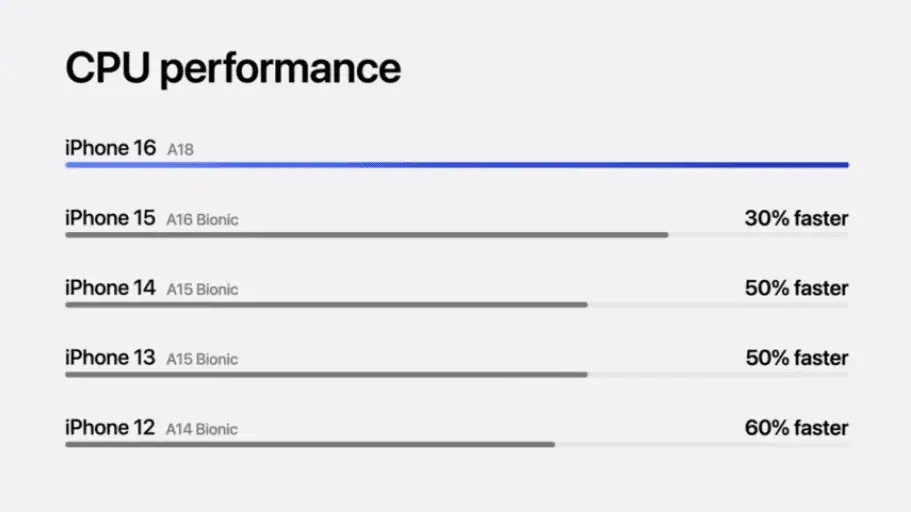On September 10, Apple finally released the iPhone 16 series smartphones, and the performance of the A18 processor featured in the iPhone 16 and iPhone 16 Plus has been highly anticipated.
The A18 processor is built using TSMC’s second-generation 3-nanometer node process, which means it offers slightly better computing and power efficiency than the previous generation A17 Pro, found in the iPhone 15 Pro and iPhone 15 Pro Max.

Interestingly, Apple only compared the A18 processor with the A16 Bionic in its performance comparison chart, with no mention of the A17 Pro, suggesting that Apple may believe there is no significant performance difference between the two.
The A18 features a 6-core configuration, including 2 performance cores and 4 efficiency cores. It also comes with a 5-core GPU and a 16-core NPU responsible for executing Apple Intelligence’s generative AI functions both in the cloud and on the device, doubling the machine learning speed compared to the previous generation.

The A18’s cache bandwidth has increased by 17%, providing the same performance as the iPhone 15, but with a 30% reduction in power consumption.
Apple also noted that in terms of CPU performance, the A18 has improved by 30%. As for the GPU tests, performance has increased by 40%.
What has sparked curiosity is that the previous generation A17 Pro was not included in this performance comparison, suggesting that there may be no significant differences between these two processors.

However, for those who have been following Apple’s events for years, this news doesn’t seem surprising, as the tech giant often compares its new processors with older chips from years ago, making the new ones appear significantly better.
One of Apple’s moves this time was to compare the iPhone 16 and iPhone 16 Plus with their predecessors, the iPhone 15 and iPhone 15 Plus. However, the iPhone 15 and iPhone 15 Plus were equipped with the A16 processor, not the A17 Pro, which was also used in the iPhone 14 Pro and iPhone 14 Pro Max models.
Additionally, it’s worth noting that during the presentation of the iPhone 16 Pro and iPhone 16 Pro Max, Apple mentioned that the A18 Pro is 15% faster than the A17 Pro, indicating that the difference between the A18 Pro and the A18 processor will be even smaller.
Related:
- iPhone Manufacturing in India Expands 14x Since 2020
- iPhone 16 USB 2.0: A 24-Year Legacy Continues!
- Limit iPhone Charging to 80% for Better Battery Life
- iPhone 17 Series Faces Delay from TSMC 2nm Setback
- iPhone 16e Benchmark Shows 16% GPU Decline, Same CPU

Disclaimer:
- This channel does not make any representations or warranties regarding the availability, accuracy, timeliness, effectiveness, or completeness of any information posted. It hereby disclaims any liability or consequences arising from the use of the information.
- This channel is non-commercial and non-profit. The re-posted content does not signify endorsement of its views or responsibility for its authenticity. It does not intend to constitute any other guidance. This channel is not liable for any inaccuracies or errors in the re-posted or published information, directly or indirectly.
- Some data, materials, text, images, etc., used in this channel are sourced from the internet, and all reposts are duly credited to their sources. If you discover any work that infringes on your intellectual property rights or personal legal interests, please contact us, and we will promptly modify or remove it.



